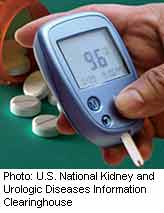- Skip Storing This Everyday Product in the Fridge Door
- Green Tea + B3 Pairing May Boost Brain Health
- Navigating Your Midlife Crisis: Embracing New Possibilities
- City Raccoons Showing Signs of Domestication
- Mapping the Exposome: Science Broadens Focus to Environmental Disease Triggers
- One Week Less on Social Media Linked to Better Mental Health
- Your Brain Changes in Stages as You Age, Study Finds
- Some Suicide Victims Show No Typical Warning Signs, Study Finds
- ByHeart Formula Faces Lawsuits After Babies Sickened With Botulism
- Switch to Vegan Diet Could Cut Your Greenhouse Gas Emissions in Half
Statins Linked to Raised Risk of Type 2 Diabetes


Cholesterol-lowering statin drugs may significantly increase a person’s risk of developing type 2 diabetes, a new study from Finland suggests.
Researchers found that statins were associated with an almost 50 percent higher risk of developing type 2 diabetes, even after adjusting for other factors.
Statins appear to increase the risk of type 2 diabetes in several ways, the researchers said. One is that the drugs can increase a person’s insulin resistance, and the other is that the cholesterol-lowering drugs seem to impair the ability of the pancreas to secrete insulin, according to the report.
Commenting on the study, Dr. Ronald Goldberg, director of the Lipid Disorder Clinic and associate director of the Diabetes Research Institute at the University of Miami, said the researchers “show evidence that statins increased insulin resistance, and that the people who developed diabetes appeared to have less ability to respond to the insulin resistance by making more insulin.”
The study authors noted, however, that their research only found an association between statin use and diabetes risk. And since the study was limited to white men, it’s not clear if the findings would apply to women or other racial groups.
More than 29 million people in the United States have diabetes, according to the American Diabetes Association (ADA). Type 2 diabetes occurs when the body becomes resistant to insulin, a hormone needed to process the sugars found in foods. To compensate, the body produces more insulin. Excess weight and a sedentary lifestyle are two important risk factors for type 2 diabetes, according to the ADA.
Prior studies have indicated that statins may increase a person’s risk of diabetes, the authors said in background information in the study. However, these earlier studies were focused mainly on statins’ role in preventing heart disease, not on their potential diabetes risk.
In this new study, University of Eastern Finland researchers tracked the effects of statin treatment in almost 9,000 men without diabetes over the course of six years. The men were between 45 and 73 years old. One in four of the men was taking a statin at the beginning of the study.
The health of the men was followed for nearly six years. During that time, 625 men were newly diagnosed with type 2 diabetes, the researchers said. Even after other risk factors were accounted for, people treated with statins were 46 percent more likely to develop diabetes than those not treated with statins.
The diabetes risk increased with the dosage taken of the statin drugs simvastatin (Zocor) and atorvastatin (Lipitor), the researchers said.
Digging a little deeper, the investigators found that statins decreased insulin sensitivity by 24 percent, and insulin secretion by 12 percent. The more simvastatin and atorvastatin that people took, the more their ability to use and produce insulin suffered.
High-dose simvastatin was associated with a 44 percent increased risk of developing diabetes, while for low-dose simvastatin the increased risk was 28 percent. High-dose atorvastatin was linked to a 37 percent increased diabetes risk, the study found.
Based on these findings, physicians will have to weigh risks versus benefits before prescribing statins, said Dr. Al Powers, director of the division of diabetes, endocrinology and metabolism at Vanderbilt University Medical Center.
Patients with pre-diabetes will need particular consideration, given that they are already on the verge of developing type 2 diabetes, Powers said.
“That’s a situation where the physician and the patient must weigh the risks and benefits and decide what to do,” Powers said.
On the other hand, statins can be prescribed without concern to people already diagnosed with type 2 diabetes, since they are already being treated for the condition, he added. “Those patients should continue their statin treatment,” Powers said.
Goldberg expects that most heart patients who need statins will continue to receive them, but with close monitoring of their blood sugar levels.
“If your risk for heart disease is high, the benefit of statin therapy is so important that most physicians and most patients, when it’s explained to them, will be willing to incur the increased risk of diabetes in favor of the added benefit to preventing heart attack and stroke,” Goldberg said.
Dr. Alan Garber, a professor at Baylor College of Medicine, said that statin users with blood sugar levels beginning to creep up can likely head off type 2 diabetes through diet and exercise. Garber is the editor of the journal Diabetes, Obesity and Metabolism.
“The solution is lifestyle modification with diet and exercise. You should do that for high cholesterol, anyway,” Garber said. “There’s no simple cure-all for all the risk factors in life. It’s clear that a single pill isn’t going to supplant individual self-management. Patients have to learn to take care of themselves.”
The findings were published March 4 in Diabetologia, the journal of the European Association for the Study of Diabetes.
More information
For more on statins, visit the U.S. National Library of Medicine.
Source: HealthDay
Copyright © 2025 HealthDay. All rights reserved.










